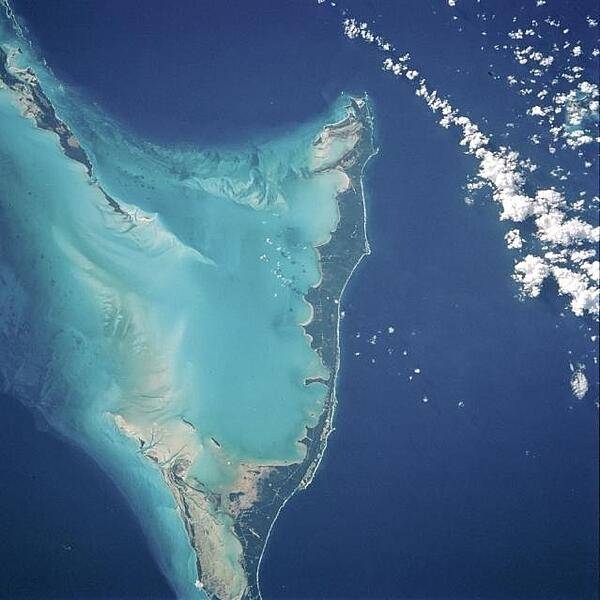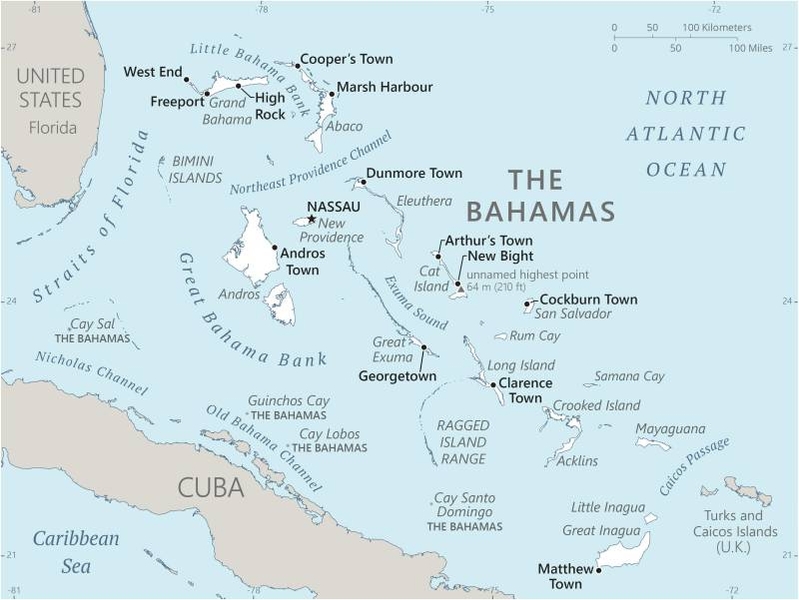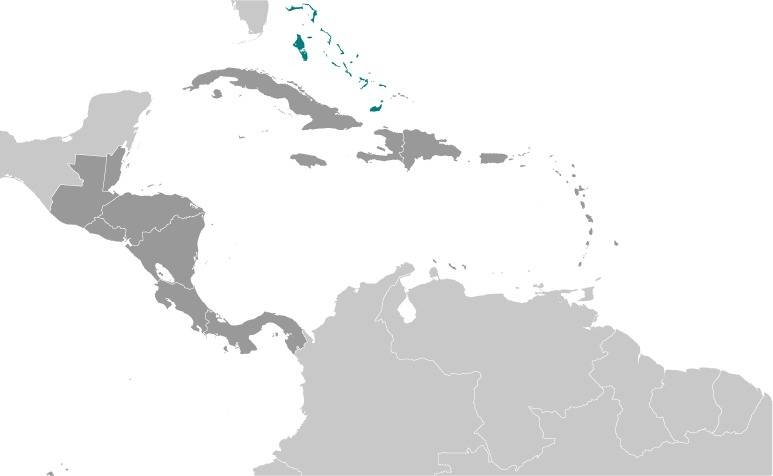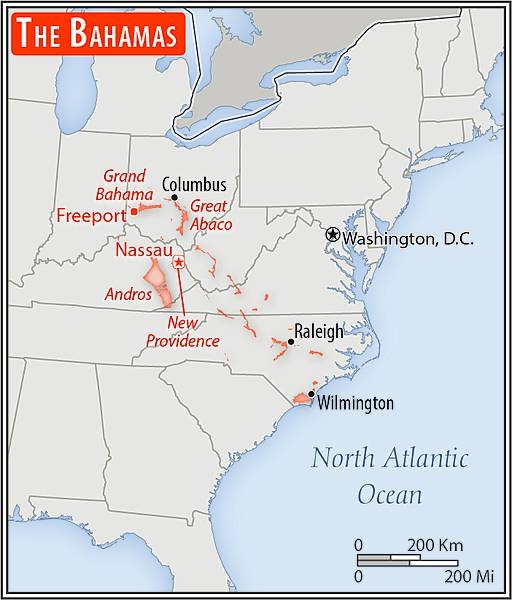Introduction
Background
Lucayan Indians inhabited the islands when Christopher COLUMBUS first set foot in the New World on San Salvador in 1492. British settlement of the islands began in 1647; the islands became a colony in 1783. Piracy thrived in the 17th and 18th centuries because of The Bahamas close proximity to shipping lanes. Since attaining independence from the UK in 1973, The Bahamas has prospered through tourism, international banking, and investment management, which comprise up to 85% of GDP. Because of its proximity to the US - the nearest Bahamian landmass being only 80 km (50 mi) from Florida - the country is a major transshipment point for illicit trafficking, particularly to the US mainland, as well as Europe. US law enforcement agencies cooperate closely with The Bahamas, and the US Coast Guard assists Bahamian authorities in maritime security and law enforcement through Operation Bahamas, Turks and Caicos, or OPBAT.
Visit the Definitions and Notes page to view a description of each topic.
Geography
Location
chain of islands in the North Atlantic Ocean, southeast of Florida, northeast of Cuba; note - although The Bahamas does not border the Caribbean Sea, geopolitically it is often designated as a Caribbean nation
Geographic coordinates
24 15 N, 76 00 W
Map references
Central America and the Caribbean
Land boundaries
total: 0 km
Coastline
3,542 km
Maritime claims
territorial sea: 12 nm
exclusive economic zone: 200 nm
Climate
tropical marine; moderated by warm waters of Gulf Stream
Terrain
long, flat coral formations with some low rounded hills
Elevation
highest point: 1.3 km NE of Old Bight on Cat Island 64 m
lowest point: Atlantic Ocean 0 m
Natural resources
salt, aragonite, timber, arable land
Land use
agricultural land: 1.4% (2018 est.)
arable land: 0.8% (2018 est.)
permanent crops: 0.4% (2018 est.)
permanent pasture: 0.2% (2018 est.)
forest: 51.4% (2018 est.)
other: 47.2% (2018 est.)
Irrigated land
10 sq km (2012)
Population distribution
most of the population lives in urban areas, with two-thirds living on New Providence Island where Nassau is located
Natural hazards
hurricanes and other tropical storms cause extensive flood and wind damage
Geography - note
strategic location adjacent to US and Cuba; extensive island chain of which 30 are inhabited
People and Society
Nationality
noun: Bahamian(s)
adjective: Bahamian
Ethnic groups
African descent 90.6%, White 4.7%, mixed 2.1%, other 1.9%, unspecified 0.7% (2010 est.)
note: data represent population by racial group
Languages
English (official), Creole (among Haitian immigrants)
Religions
Protestant 69.9% (includes Baptist 34.9%, Anglican 13.7%, Pentecostal 8.9% Seventh Day Adventist 4.4%, Methodist 3.6%, Church of God 1.9%, Brethren 1.6%, other Protestant .9%), Roman Catholic 12%, other Christian 13% (includes Jehovah's Witness 1.1%), other 0.6%, none 1.9%, unspecified 2.6% (2010 est.)
Age structure
0-14 years: 21.7% (male 38,811/female 37,719)
15-24 years: 14.91% (male 26,636/female 25,945)
25-54 years: 43.56% (male 76,505/female 77,119)
55-64 years: 10.75% (male 17,508/female 20,391)
65 years and over: 9.08% (male 12,587/female 19,434) (2021 est.)
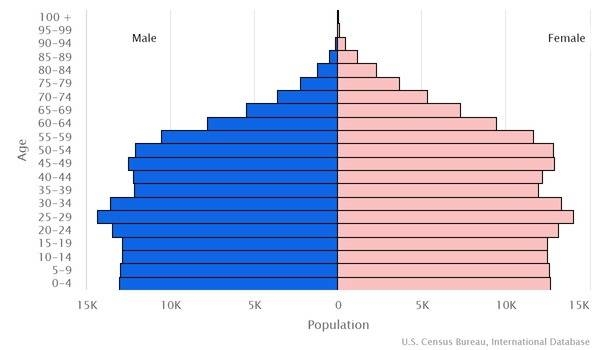
Dependency ratios
total dependency ratio: 39.3
youth dependency ratio: 27.3
elderly dependency ratio: 11.9
potential support ratio: 8.4 (2021 est.)
Median age
total: 32.8 years
male: 31.7 years
female: 34 years (2020 est.)
Population distribution
most of the population lives in urban areas, with two-thirds living on New Providence Island where Nassau is located
Urbanization
urban population: 83.6% of total population (2023)
rate of urbanization: 1.02% annual rate of change (2020-25 est.)
Major urban areas - population
280,000 NASSAU (capital) (2018)
Sex ratio
at birth: 1.03 male(s)/female
0-14 years: 1.03 male(s)/female
15-24 years: 1.03 male(s)/female
25-54 years: 0.99 male(s)/female
55-64 years: 0.86 male(s)/female
65 years and over: 0.5 male(s)/female
total population: 0.95 male(s)/female (2022 est.)
Maternal mortality ratio
70 deaths/100,000 live births (2017 est.)
country comparison to the world: 83Infant mortality rate
total: 12.78 deaths/1,000 live births
male: 13.22 deaths/1,000 live births
female: 12.33 deaths/1,000 live births (2022 est.)
Life expectancy at birth
total population: 76.13 years
male: 73.2 years
female: 79.14 years (2022 est.)
Drinking water source
improved: total: 98.9% of population
unimproved: total: 1.1% of population (2017 est.)
Current health expenditure
5.8% of GDP (2019)
Physicians density
1.94 physicians/1,000 population (2017)
Hospital bed density
3 beds/1,000 population (2017)
Sanitation facility access
improved: total: 98.2% of population
unimproved: total: 1.8% of population (2017 est.)
Alcohol consumption per capita
total: 9.48 liters of pure alcohol (2019 est.)
beer: 3.66 liters of pure alcohol (2019 est.)
wine: 1.43 liters of pure alcohol (2019 est.)
spirits: 4.08 liters of pure alcohol (2019 est.)
other alcohols: 0.31 liters of pure alcohol (2019 est.)
Tobacco use
total: 10.6% (2020 est.)
male: 18.8% (2020 est.)
female: 2.4% (2020 est.)
Literacy
total population: NA
male: NA
female: NA
Youth unemployment rate (ages 15-24)
total: 25.8%
male: 20.8%
female: 31.6% (2016 est.)
Environment
Environment - current issues
coral reef decay; solid waste disposal
Environment - international agreements
party to: Biodiversity, Climate Change, Climate Change-Kyoto Protocol, Climate Change-Paris Agreement, Comprehensive Nuclear Test Ban, Desertification, Endangered Species, Hazardous Wastes, Law of the Sea, Nuclear Test Ban, Ozone Layer Protection, Ship Pollution, Wetlands
signed, but not ratified: none of the selected agreements
Air pollutants
particulate matter emissions: 17.56 micrograms per cubic meter (2016 est.)
carbon dioxide emissions: 1.79 megatons (2016 est.)
methane emissions: 0.23 megatons (2020 est.)
Climate
tropical marine; moderated by warm waters of Gulf Stream
Land use
agricultural land: 1.4% (2018 est.)
arable land: 0.8% (2018 est.)
permanent crops: 0.4% (2018 est.)
permanent pasture: 0.2% (2018 est.)
forest: 51.4% (2018 est.)
other: 47.2% (2018 est.)
Urbanization
urban population: 83.6% of total population (2023)
rate of urbanization: 1.02% annual rate of change (2020-25 est.)
Revenue from forest resources
forest revenues: 0.01% of GDP (2018 est.)
country comparison to the world: 146Waste and recycling
municipal solid waste generated annually: 264,000 tons (2015 est.)
Total water withdrawal
municipal: 31 million cubic meters (2017 est.)
Total renewable water resources
700 million cubic meters (2017 est.)
Government
Country name
conventional long form: Commonwealth of The Bahamas
conventional short form: The Bahamas
etymology: name derives from the Spanish "baha mar," meaning "shallow sea," which describes the shallow waters of the Bahama Banks
Government type
parliamentary democracy under a constitutional monarchy; a Commonwealth realm
Capital
name: Nassau
geographic coordinates: 25 05 N, 77 21 W
time difference: UTC-5 (same time as Washington, DC, during Standard Time)
daylight saving time: +1hr, begins second Sunday in March; ends first Sunday in November
etymology: named after William III (1650-1702), king of England, Scotland, and Ireland, who was a member of the House of Nassau
Administrative divisions
31 districts; Acklins Islands, Berry Islands, Bimini, Black Point, Cat Island, Central Abaco, Central Andros, Central Eleuthera, City of Freeport, Crooked Island and Long Cay, East Grand Bahama, Exuma, Grand Cay, Harbour Island, Hope Town, Inagua, Long Island, Mangrove Cay, Mayaguana, Moore's Island, North Abaco, North Andros, North Eleuthera, Ragged Island, Rum Cay, San Salvador, South Abaco, South Andros, South Eleuthera, Spanish Wells, West Grand Bahama
Independence
10 July 1973 (from the UK)
National holiday
Independence Day, 10 July (1973)
Constitution
history: previous 1964 (preindependence); latest adopted 20 June 1973, effective 10 July 1973
amendments: proposed as an "Act" by Parliament; passage of amendments to articles such as the organization and composition of the branches of government requires approval by at least two-thirds majority of the membership of both houses of Parliament and majority approval in a referendum; passage of amendments to constitutional articles such as fundamental rights and individual freedoms, the powers, authorities, and procedures of the branches of government, or changes to the Bahamas Independence Act 1973 requires approval by at least three-fourths majority of the membership of both houses and majority approval in a referendum; amended many times, last in 2016
Legal system
common law system based on the English model
International law organization participation
has not submitted an ICJ jurisdiction declaration; non-party state to the ICCt
Citizenship
citizenship by birth: no
citizenship by descent only: at least one parent must be a citizen of The Bahamas
dual citizenship recognized: no
residency requirement for naturalization: 6-9 years
Suffrage
18 years of age; universal
Executive branch
chief of state: King CHARLES III (since 8 September 2022); represented by Governor General Cornelius A. SMITH (since 28 June 2019)
head of government: Prime Minister Philip DAVIS (since 17 September 2021)
cabinet: Cabinet appointed by governor general on recommendation of prime minister
elections/appointments: the monarchy is hereditary; governor general appointed by the monarch on the advice of the prime minister; following legislative elections, the leader of the majority party or majority coalition usually appointed prime minister by the governor general; the prime minister recommends the deputy prime minister
Legislative branch
description: bicameral Parliament consists of:
Senate (16 seats; members appointed by the governor general - 9 selected on the advice of the prime minister, 4 on the advice of the leader of the opposition party, and 3 on the advice of the prime minister in consultation with the opposition leader; members serve 5-year terms)
House of Assembly (39 seats; members directly elected in single-seat constituencies by simple majority vote to serve 5-year terms)
elections:
Senate - last appointments on 24 May 2017 (next appointments in 2022)
House of Assembly - last held on 16 September 2021 (next to be held by September 2026)
election results:
Senate - appointed; composition as of March 2022 - men 12, women 4, percent of women 25%
House of Assembly - percent of vote by party - PLP 52.5%, FNM 36.2%; seats by party - PLP 32, FNM 7; composition as of March 2022 - men 32, women 7, percent of women 18%; note - total Parliament percent of women 20%
note: the government may dissolve the parliament and call elections at any time
Judicial branch
highest court(s): Court of Appeal (consists of the court president and 4 justices, organized in 3-member panels); Supreme Court (consists of the chief justice and a maximum of 11 and a minimum of 2 justices)
judge selection and term of office: Court of Appeal president and Supreme Court chief justice appointed by the governor-general on the advice of the prime minister after consultation with the leader of the opposition party; other Court of Appeal and Supreme Court justices appointed by the governor general upon recommendation of the Judicial and Legal Services Commission, a 5-member body headed by the chief justice; Court of Appeal justices appointed for life with mandatory retirement normally at age 68 but can be extended until age 70; Supreme Court justices appointed for life with mandatory retirement normally at age 65 but can be extended until age 67
subordinate courts: Industrial Tribunal; Stipendiary and Magistrates' Courts; Family Island Administrators
note: The Bahamas is a member of the 15-member Caribbean Community but is not party to the agreement establishing the Caribbean Court of Justice as its highest appellate court; the Judicial Committee of the Privy Council (in London) serves as the final court of appeal for The Bahamas
Political parties and leaders
Democratic National Alliance or DNA [Arinthia KOMOLAFE]
Free National Movement or FNM [Michael PINTARD]
Progressive Liberal Party or PLP [Philip "Brave" DAVIS]
International organization participation
ACP, AOSIS, C, Caricom, CDB, CELAC, FAO, G-77, IADB, IAEA, IBRD, ICAO, ICC (NGOs), ICRM, IDA, IFAD, IFC, IFRCS, ILO, IMF, IMO, IMSO, Interpol, IOC, IOM, ISO (correspondent), ITSO, ITU, LAES, MIGA, NAM, OAS, OPANAL, OPCW, Petrocaribe, UN, UNCTAD, UNESCO, UNIDO, UNWTO, UPU, WCO, WHO, WIPO, WMO, WTO (observer)
Diplomatic representation in the US
chief of mission: Ambassador Wendall Kermith JONES (since 19 April 2022)
chancery: 600 New Hampshire Ave NW, Suite 530, Washington, DC 20037
telephone: [1] (202) 319-2660
FAX: [1] (202) 319-2668
email address and website:
embassy@bahamasembdc.org
https://www.bahamasembdc.org/
consulate(s) general: Atlanta, Miami, New York, Washington, DC
Diplomatic representation from the US
chief of mission: Ambassador (vacant); Charge d' Affaires Usha E. PITTS (since 1 January 2021)
embassy: 42 Queen Street, Nassau
mailing address: 3370 Nassau Place, Washington, DC 20521-3370
telephone: [1] (242) 322-1181
FAX: [1] (242) 356-7174
email address and website:
acsnassau@state.gov
https://bs.usembassy.gov/
Flag description
three equal horizontal bands of aquamarine (top), gold, and aquamarine, with a black equilateral triangle based on the hoist side; the band colors represent the golden beaches of the islands surrounded by the aquamarine sea; black represents the vigor and force of a united people, while the pointing triangle indicates the enterprise and determination of the Bahamian people to develop the rich resources of land and sea
National symbol(s)
blue marlin, flamingo, Yellow Elder flower; national colors: aquamarine, yellow, black
National anthem
name: "March On, Bahamaland!"
lyrics/music: Timothy GIBSON
note: adopted 1973; as a Commonwealth country, in addition to the national anthem, "God Save the King" serves as the royal anthem (see United Kingdom)
Economy
Economic overview
The Bahamas has the second highest per capita GDP in the English-speaking Caribbean with an economy heavily dependent on tourism and financial services. Tourism accounts for approximately 50% of GDP and directly or indirectly employs half of the archipelago's labor force. Financial services constitute the second-most important sector of the Bahamian economy, accounting for about 15% of GDP. Manufacturing and agriculture combined contribute less than 7% of GDP and show little growth, despite government incentives aimed at those sectors. The new government led by Prime Minister Hubert MINNIS has prioritized addressing fiscal imbalances and rising debt, which stood at 75% of GDP in 2016. Large capital projects like the Baha Mar Casino and Hotel are driving growth. Public debt increased in 2017 in large part due to hurricane reconstruction and relief financing. The primary fiscal balance was a deficit of 0.4% of GDP in 2016. The Bahamas is the only country in the Western Hemisphere that is not a member of the World Trade Organization.
Real GDP (purchasing power parity)
$12.1 billion (2020 est.)
$14.45 billion (2019 est.)
$14.28 billion (2018 est.)
note: data are in 2017 dollars
Real GDP growth rate
1.4% (2017 est.)
-1.7% (2016 est.)
1% (2015 est.)
Real GDP per capita
$30,800 (2020 est.)
$37,100 (2019 est.)
$37,000 (2018 est.)
note: data are in 2017 dollars
GDP (official exchange rate)
$12.16 billion (2017 est.)
Inflation rate (consumer prices)
1.4% (2017 est.)
-0.3% (2016 est.)
Credit ratings
Moody's rating: Ba2 (2020)
Standard & Poors rating: BB- (2020)
note: The year refers to the year in which the current credit rating was first obtained.
GDP - composition, by sector of origin
agriculture: 2.3% (2017 est.)
industry: 7.7% (2017 est.)
services: 90% (2017 est.)
GDP - composition, by end use
household consumption: 68% (2017 est.)
government consumption: 13% (2017 est.)
investment in fixed capital: 26.3% (2017 est.)
investment in inventories: 0.7% (2017 est.)
exports of goods and services: 33.7% (2017 est.)
imports of goods and services: -41.8% (2017 est.)
Agricultural products
sugar cane, grapefruit, vegetables, bananas, tomatoes, poultry, tropical fruit, oranges, coconuts, mangoes/guavas
Industries
tourism, banking, oil bunkering, maritime industries, transshipment and logistics, salt, aragonite, pharmaceuticals
Labor force - by occupation
agriculture: 3%
industry: 11%
services: 49%
tourism: 37% (2011 est.)
Youth unemployment rate (ages 15-24)
total: 25.8%
male: 20.8%
female: 31.6% (2016 est.)
Population below poverty line
9.3% (2010 est.)
Household income or consumption by percentage share
lowest 10%: 1%
highest 10%: 22% (2007 est.)
Budget
revenues: 2.139 billion (2017 est.)
expenditures: 2.46 billion (2017 est.)
Fiscal year
1 July - 30 June
Current account balance
-$1.909 billion (2017 est.)
-$868 million (2016 est.)
Exports
$1.69 billion (2020 est.)
$5.14 billion (2019 est.)
$4.75 billion (2018 est.)
note: Data are in current year dollars and do not include illicit exports or re-exports.
Exports - partners
Poland 32%, United States 17%, Ecuador 9%, China 6%, Japan 5% (2019)
Exports - commodities
ships, refined petroleum, nitrogen compounds, crustaceans, styrene polymers (2019)
Imports
$3.64 billion (2020 est.) note: data are in current year dollars
$4.91 billion (2019 est.) note: data are in current year dollars
$5.12 billion (2018 est.) note: data are in current year dollars
Imports - partners
United States 31%, South Korea 29%, Japan 14% (2019)
Imports - commodities
ships, refined petroleum, crude petroleum, recreational boats, cars (2019)
Reserves of foreign exchange and gold
$1.522 billion (31 December 2017 est.)
$1.002 billion (31 December 2016 est.)
Debt - external
$17.56 billion (31 December 2013 est.)
$16.35 billion (31 December 2012 est.)
Exchange rates
Bahamian dollars (BSD) per US dollar -
1 (2017 est.)
1 (2016 est.)
1 (2015 est.)
1 (2014 est.)
1 (2013 est.)
Energy
Electricity access
electrification - total population: 100% (2020)
Electricity
installed generating capacity: 578,000 kW (2020 est.)
consumption: 2,103,248,000 kWh (2019 est.)
exports: 0 kWh (2019 est.)
imports: 0 kWh (2020 est.)
transmission/distribution losses: 245,000 kWh (2019 est.)
Electricity generation sources
fossil fuels: 99.8% of total installed capacity (2020 est.)
nuclear: 0% of total installed capacity (2020 est.)
solar: 0.2% of total installed capacity (2020 est.)
wind: 0% of total installed capacity (2020 est.)
hydroelectricity: 0% of total installed capacity (2020 est.)
tide and wave: 0% of total installed capacity (2020 est.)
geothermal: 0% of total installed capacity (2020 est.)
biomass and waste: 0% of total installed capacity (2020 est.)
Coal
production: 0 metric tons (2020 est.)
consumption: 0 metric tons (2020 est.)
exports: 0 metric tons (2020 est.)
imports: 0 metric tons (2020 est.)
proven reserves: 0 metric tons (2019 est.)
Petroleum
total petroleum production: 0 bbl/day (2021 est.)
refined petroleum consumption: 25,800 bbl/day (2019 est.)
crude oil and lease condensate exports: 0 bbl/day (2018 est.)
crude oil and lease condensate imports: 0 bbl/day (2018 est.)
crude oil estimated reserves: 0 barrels (2021 est.)
Natural gas
production: 0 cubic meters (2021 est.)
consumption: 4.417 million cubic meters (2019 est.)
exports: 0 cubic meters (2021 est.)
imports: 4.417 million cubic meters (2019 est.)
proven reserves: 0 cubic meters (2021 est.)
Carbon dioxide emissions
3.984 million metric tonnes of CO2 (2019 est.)
from coal and metallurgical coke: 0 metric tonnes of CO2 (2019 est.)
from petroleum and other liquids: 3.976 million metric tonnes of CO2 (2019 est.)
from consumed natural gas: 7,000 metric tonnes of CO2 (2019 est.)
Energy consumption per capita
140.505 million Btu/person (2019 est.)
country comparison to the world: 37Communications
Telephones - fixed lines
total subscriptions: 91,000 (2020 est.)
subscriptions per 100 inhabitants: 23 (2020 est.)
Telephones - mobile cellular
total subscriptions: 466,000 (2020 est.)
subscriptions per 100 inhabitants: 119 (2020 est.)
Telecommunication systems
general assessment: the telecom sector has seen a decline in subscriber numbers (particularly for prepaid mobile services the mainstay of short term visitors) and revenue; fixed and mobile broadband services are two areas that have benefited from the crisis as employees and students have resorted to working from home (2021)
domestic: 23 per 100 fixed-line, 119 per 100 mobile-cellular (2020)
international: country code - 1-242; landing points for the ARCOS-1, BICS, Bahamas 2-US, and BDSN fiber-optic submarine cables that provide links to South and Central America, parts of the Caribbean, and the US; satellite earth stations - 2; the Bahamas Domestic Submarine Network links all of the major islands; (2019)
note: the COVID-19 pandemic continues to have a significant impact on production and supply chains globally; since 2020, some aspects of the telecom sector have experienced a downturn, particularly in mobile device production; progress toward 5G implementation has resumed, as well as upgrades to infrastructure; consumer spending on telecom services has increased due to the surge in demand for capacity and bandwidth; the crucial nature of telecom services as a tool for work and school from home is still evident, and the spike in this area has seen growth opportunities for development of new tools and increased services
Broadcast media
The Bahamas has 4 major TV providers that provide service to all major islands in the archipelago; 1 TV station is operated by government-owned, commercially run Broadcasting Corporation of the Bahamas (BCB) and competes freely with 4 privately owned TV stations; multi-channel cable TV subscription service is widely available; there are 32 licensed broadcast (radio) service providers, 31 are privately owned FM radio stations operating on New Providence, Grand Bahama Island, Abaco Island, and on smaller islands in the country; the BCB operates a multi-channel radio broadcasting network that has national coverage; the sector is regulated by the Utilities Regulation and Competition Authority (2019)
Internet users
total: 342,126 (2020 est.)
percent of population: 87% (2020 est.)
Broadband - fixed subscriptions
total: 83,000 (2020 est.)
subscriptions per 100 inhabitants: 21 (2020 est.)
Transportation
National air transport system
number of registered air carriers: 5 (2020)
inventory of registered aircraft operated by air carriers: 35
annual passenger traffic on registered air carriers: 1,197,116 (2018)
annual freight traffic on registered air carriers: 160,000 (2018) mt-km
Airports - with paved runways
total: 24
over 3,047 m: 2
2,438 to 3,047 m: 2
1,524 to 2,437 m: 13
914 to 1,523 m: 7 (2021)
Airports - with unpaved runways
total: 37
1,524 to 2,437 m: 4
914 to 1,523 m: 16
under 914 m: 17 (2021)
Heliports
1 (2021)
Roadways
total: 2,700 km (2011)
paved: 1,620 km (2011)
unpaved: 1,080 km (2011)
Merchant marine
total: 1,323
by type: bulk carrier 333, container ship 45, general cargo 64, oil tanker 224, other 657 (2021)
Ports and terminals
major seaport(s): Freeport, Nassau, South Riding Point
cruise port(s): Nassau
container port(s) (TEUs): Freeport (1,396,568) (2019)
Military and Security
Military and security forces
Royal Bahamas Defense Force (RBDF): includes land, air, maritime elements (2022)
note: the RBDF is primarily responsible for external security but also provides security at a detention center for migrants and performs some domestic security functions, such as guarding embassies; the Royal Bahamas Police Force (RBPF) maintains internal security; both the RBDF and the RBPF report to the minister of national security
Military expenditures
0.8% of GDP (2022 est.)
0.9% of GDP (2021)
0.9% of GDP (2020)
0.7% of GDP (2019)
0.7% of GDP (2018)
Military and security service personnel strengths
approximately 1,500 active RBDF personnel (2022)
Military equipment inventories and acquisitions
most of the RBDF's major equipment inventory is supplied by the Netherlands (2022)
Military service age and obligation
18 years of age for voluntary male and female service; no conscription (2022)
Military - note
the RBDF was established in 1980; its primary responsibilities are disaster relief, maritime security, and counter-narcotics operations; it is a naval force, but includes a lightly-armed marine infantry/commando squadron for base and internal security, as well as a few light non-combat aircraft; the maritime element has coastal patrol craft and patrol boats; the RBDF maintains training relationships with the UK and the US (2022)
Transnational Issues
Disputes - international
The Bahamas-US (Maritime Boundary): In declaring its archipelagic waters and 200 nm EEZ in 1993 legislation, The Bahamas did not delimit the outer limits of the EEZ; but in areas where EEZs overlap with neighbors, The Bahamas agreed to equidistance as a line of separation. However, The Bahamas has yet to define maritime boundaries with any of its neighbors, including the United States, whose Florida coast lays about 70 nm from Grand Bahama Island.
Illicit drugs
a significant transit point for illegal drugs bound for the United States; illicit production of marijuana continues
